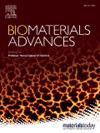核壳型锌磷掺杂硅酸钙生物陶瓷的时空降解调控和高效成骨修复
IF 6
2区 医学
Q2 MATERIALS SCIENCE, BIOMATERIALS
Materials Science & Engineering C-Materials for Biological Applications
Pub Date : 2025-07-21
DOI:10.1016/j.bioadv.2025.214429
引用次数: 0
摘要
钙硅酸盐(CSi)生物陶瓷在骨组织工程中引起了极大的兴趣,但它们的多功能和生物降解在一些紧急骨创伤条件下是不理想的。外来离子掺杂和核壳结构设计为优化成骨效果提供了有前途的策略,同时精确调节降解动力学和生物功能离子释放。本文通过同轴喷嘴体系制备了核-壳多孔生物陶瓷,其核心为磷掺杂硅灰石(CSi-P)芯层和锌掺杂硅灰石(CSi-Zn)/β-磷酸三钙(β-TCP)壳层。在壳层中添加10%的孔隙素可以实现可控的微孔结构。体外研究表明,锌掺杂可以很好地调节硅壳的降解速率,控制生物活性离子的物理溶解和持续释放。基于csi的组件在模拟体液中进一步表现出优异的仿生再矿化能力。同时,P12@Zn8和P12@Zn12对革兰氏阳性菌(金黄色葡萄球菌)均表现出显著的抑菌潜力。体内下颌骨缺损实验显示,CSi-Zn颗粒在10周和16周的骨修复效果优于β-TCP颗粒。值得注意的是,P12@Zn8配方实现了最佳的降解-成骨耦合,在16周内表现出增强的小梁骨形成和完全修复。这种核壳设计策略地平衡了可调降解与时空生物活性,并可能为临床实践中材料的吸收时间与骨再生时间的匹配问题提供解决方案。我们的研究结果强调了组成分级核-壳生物陶瓷作为新一代生物活性植入物用于紧急骨创伤再生和修复的潜力。本文章由计算机程序翻译,如有差异,请以英文原文为准。
Core-shell Zn/P-doped calcium silicate bioceramics with spatiotemporally regulated degradation and high-efficient oesteogensis for emergent bone trauma repair
Ca-silicate (CSi) bioceramics have garnered significant interest in bone tissue engineering but their multifunction and biodegradation are suboptimal for some emergent bone trauma conditions. Foreign ion doping and core-shell architectural design offer promising strategies to optimize osteogenic efficacy while precisely regulating degradation kinetics and biologically functional ion release. Herein we developed the core-shell porous bioceramics via coaxial nozzle system, featuring a P-doping wollastonite (CSi-P) core and Zn-doping wollastonite (CSi-Zn)/β-tricalcium phosphate (β-TCP) shells. A 10% porogens in the shell layer would enable controllable micropore architecture. In vitro studies demonstrated that Zn doping could finely tune the CSi-shell degradation rates, governing both physical dissolution and sustained release of bioactive ions. The CSi-based components further exhibited superior biomimetic remineralization capability in simulated body fluid. Meanwhile, both P12@Zn8 and P12@Zn12 exhibited remarkable antibacterial potential against Gram-positive bacteria (S. aureus). In vivo mandibular defect experiments revealed that the CSi-Zn granules outperformed β-TCP counterparts in bone repair at 10 and 16 weeks interval. Notably, the P12@Zn8 formulation achieved optimal degradation-osteogenesis coupling, exhibiting enhanced trabecular bone formation and complete repair within 16 weeks. This core-shell design strategically balances tunable degradation with spatiotemporal bioactivity, and may provide a solution to the problem of matching the absorption time of the materials with the bone regeneration time in clinical practice. Our findings highlight the potential of compositionally graded core-shell bioceramics as next-generation bioactive implants for emergent bone trauma regeneration and repair.
求助全文
通过发布文献求助,成功后即可免费获取论文全文。
去求助
来源期刊
CiteScore
17.80
自引率
0.00%
发文量
501
审稿时长
27 days
期刊介绍:
Biomaterials Advances, previously known as Materials Science and Engineering: C-Materials for Biological Applications (P-ISSN: 0928-4931, E-ISSN: 1873-0191). Includes topics at the interface of the biomedical sciences and materials engineering. These topics include:
• Bioinspired and biomimetic materials for medical applications
• Materials of biological origin for medical applications
• Materials for "active" medical applications
• Self-assembling and self-healing materials for medical applications
• "Smart" (i.e., stimulus-response) materials for medical applications
• Ceramic, metallic, polymeric, and composite materials for medical applications
• Materials for in vivo sensing
• Materials for in vivo imaging
• Materials for delivery of pharmacologic agents and vaccines
• Novel approaches for characterizing and modeling materials for medical applications
Manuscripts on biological topics without a materials science component, or manuscripts on materials science without biological applications, will not be considered for publication in Materials Science and Engineering C. New submissions are first assessed for language, scope and originality (plagiarism check) and can be desk rejected before review if they need English language improvements, are out of scope or present excessive duplication with published sources.
Biomaterials Advances sits within Elsevier''s biomaterials science portfolio alongside Biomaterials, Materials Today Bio and Biomaterials and Biosystems. As part of the broader Materials Today family, Biomaterials Advances offers authors rigorous peer review, rapid decisions, and high visibility. We look forward to receiving your submissions!

 求助内容:
求助内容: 应助结果提醒方式:
应助结果提醒方式:


